Building an inground pool is an exciting project that can greatly enhance your outdoor living space. Whether you’re dreaming of a relaxing backyard retreat or a place for family fun, understanding the process of pool construction is essential to ensure a smooth experience. From planning and design to installation, the journey of constructing an inground pool involves multiple steps. In this article, we’ll walk you through what to expect during your inground pool construction project.
Step 1: Initial Consultation and Design
The first step in your inground pool construction project is the consultation. During this phase, you’ll meet with a pool installation company to discuss your vision, preferences, and budget. The contractor will assess your property, taking into account the available space, landscaping, and any obstacles that may affect the installation.
Once the assessment is complete, the pool builder will help you design the pool layout. This includes choosing the shape, size, depth, and type of materials for your pool. Whether you’re opting for a concrete pool builder or a fiberglass pool contractor, the design phase allows you to explore various options that suit your needs. Additionally, you’ll discuss the pool’s features such as lighting, water features, and any additional landscaping elements.
After finalizing the design, the contractor will provide you with an estimate and a timeline for the project.
Step 2: Permits and Approvals
Before construction begins, you’ll need to obtain the necessary permits. Most municipalities require permits for pool installation to ensure compliance with local zoning laws and safety regulations. Your pool builder should assist you in navigating the permitting process and submitting the required documents on your behalf.
It’s essential to follow these guidelines, as not doing so could lead to delays or additional costs down the line. Some areas may have specific rules regarding setbacks (the distance between the pool and property lines), fencing requirements, and pool depth. The pool builder should be knowledgeable about these regulations and ensure that everything is in order before the work begins.
Step 3: Excavation and Ground Preparation
Once the permits are in place, the next step is excavation. This is when the pool’s shape is dug out of your yard. Depending on the pool type you’ve chosen, such as fiberglass or concrete, the excavation process may vary slightly.
For concrete pools, excavation will be done according to the specific measurements of the pool design. For fiberglass pool contractors, the hole will be sized to fit the pre-formed fiberglass shell that will be installed later.
During this phase, heavy machinery is used to dig and level the ground. The excavation process is the most disruptive part of the project, as it involves removing dirt and debris from the site. However, your pool contractor will work efficiently to minimize disruptions and complete the excavation within the agreed-upon timeline.
Step 4: Installation of Pool Shell and Plumbing
Once the excavation is complete, the next step is to install the pool shell. If you’ve chosen a fiberglass pool, the pre-formed shell will be delivered to your property and carefully lowered into the prepared hole. This process requires precision, as the shell must fit perfectly in the excavated area.
For concrete pools, the installation process involves pouring concrete into forms and creating a custom structure. This is typically done in stages, with the builder pouring the floor and walls of the pool, followed by the installation of steel reinforcements. Concrete pools offer the benefit of unlimited design possibilities, allowing for a fully customized pool shape and layout.
During this stage, the plumbing and electrical systems will also be installed. The pool builder will set up the filtration system, pumps, and any additional features like lights or heating systems. Once the plumbing and electrical work are complete, the pool shell is secured, and the focus shifts to finishing touches.
Step 5: Pool Finishing and Landscaping
After the pool shell is installed, the next step is to add the finishing touches. For fiberglass pools, the interior surface will be polished, and any necessary adjustments will be made to ensure a smooth, leak-proof finish. Concrete pools, on the other hand, require additional steps like plastering or tiling to create the final surface.
In addition to the pool itself, landscaping is an essential part of the project. This might involve adding a pool deck, installing lighting, and incorporating surrounding plants or hardscapes. The goal is to create a cohesive outdoor space that complements the pool and enhances the overall aesthetic.
During this phase, your pool builder may also add features like waterfalls, fountains, or even a hot tub, depending on your design preferences. This is the phase when your dream pool really starts to take shape!
Step 6: Final Inspections and Pool Start-Up
Once the pool is fully constructed, the final step is the inspection and pool start-up. The pool installation company will perform a thorough check to ensure everything is functioning properly, including the filtration system, electrical systems, and any added features. Once everything is in working order, the pool will be filled with water, and a start-up process will begin.
At this point, the pool contractor will test the water chemistry and adjust the levels of chlorine, pH, and other chemicals to ensure the pool is ready for use. You will also receive instructions on how to maintain your pool and care for its components.
Conclusion
Building an inground pool is an exciting and rewarding project, but it requires careful planning and coordination. By understanding what to expect at each stage of the process, from design to installation and final inspection, you can ensure that your pool construction project runs smoothly.
Whether you are working with a fiberglass pool contractor or a concrete pool builder, choosing a reliable pool installation company is crucial to bringing your vision to life. Learn more about how Tchibum Pools can help you navigate every step of your inground pool construction, ensuring a successful and stress-free project.


